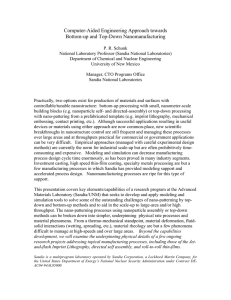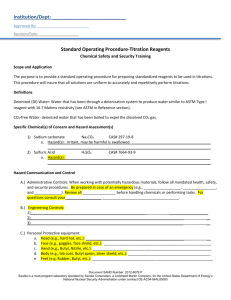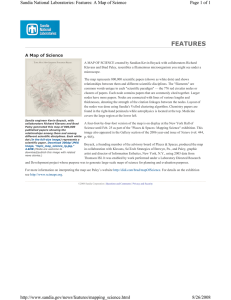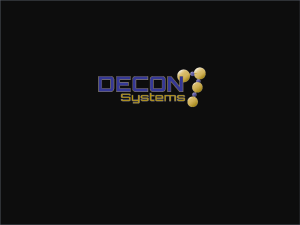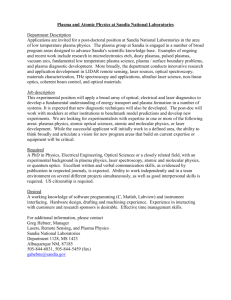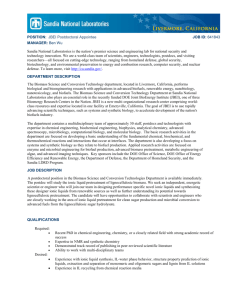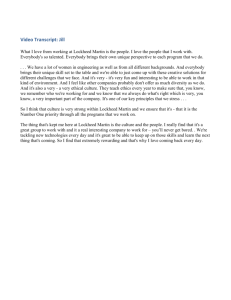LADAR Measurements of the International Space Station LADAR Guidance for Autonomous
advertisement
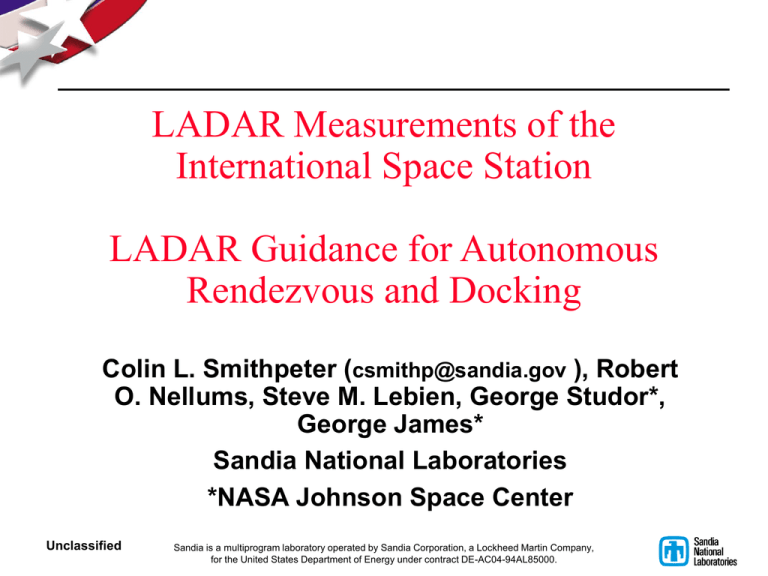
LADAR Measurements of the International Space Station LADAR Guidance for Autonomous Rendezvous and Docking Colin L. Smithpeter (csmithp@sandia.gov ), Robert O. Nellums, Steve M. Lebien, George Studor*, George James* Sandia National Laboratories *NASA Johnson Space Center Unclassified Sandia is a multiprogram laboratory operated by Sandia Corporation, a Lockheed Martin Company, for the United States Department of Energy under contract DE-AC04-94AL85000. Laser Radar • Laser Radar provides angle, angle, range images • of target Potential for small, standalone sensor in AR&C – Range & bearing with each image, day or night, uncooperative targets – 6 DOF velocities from sequential images – Target vehicle orientation from 3D images X:+2 Y:-2 Z:+20 DX:-0.2 DY:0.0 DZ:+2 Unclassified Sandia is a multiprogram laboratory operated by Sandia Corporation, a Lockheed Martin Company, for the United States Department of Energy under contract DE-AC04-94AL85000. Key Points • Laser Radar is accurate, rapid, and small – What are the issues? • Scanning Versus Scannerless – Virtually all existing ladar capabilities utilize scanning – A unique, scannerless laser radar has been developed by Sandia National Laboratories. • Laser Dynamic Range Imager (LDRI) Overview – Scannerless demonstration on STS 97 Mission in 2001. • AR&C LADAR concept • Next Generation micro LADAR Unclassified Sandia is a multiprogram laboratory operated by Sandia Corporation, a Lockheed Martin Company, for the United States Department of Energy under contract DE-AC04-94AL85000. Laser Radar Issues • Optical energy per pixel measurement – Minimum signal requirement depends upon ladar architecture, including quantum efficiency, noise, and background. Typical to require 100s of photons, but a single photon is potentially feasible. – Required illumination, given required signal, tends to vary directly with number of pixels, range2 and FOV2. Energy can become prohibitive at long range. – Temporal and spectral filtering required to reduce solar background • Target Albedo – Specular materials, such as Mylar, can be very difficult to detect – Diffuse materials, such as brushed metal or beta-cloth, provide reliable returns – Retro-reflective cubes or tapes greatly enhance return from range Unclassified Sandia is a multiprogram laboratory operated by Sandia Corporation, a Lockheed Martin Company, for the United States Department of Energy under contract DE-AC04-94AL85000. Scanning Versus Scannerless • Why Scanning – Single-channel EO can incorporate sophisticated readout of return waveform – Single axis can incorporate spatial filter: IFOV can be much smaller than pixel spacing, to reduce solar background – Variable FOV, pointing, and pixel spacing • Why Scannerless – Focal plane eliminates bulk and reliability issue of scanning mechanism – Focal plane enables fast image acquisition. Single flash feasibility. Unclassified Sandia is a multiprogram laboratory operated by Sandia Corporation, a Lockheed Martin Company, for the United States Department of Energy under contract DE-AC04-94AL85000. LADAR Sensor • Challenge: Measure laser pulse return time in each pixel with nanosecond accuracy – Nyquist indicates 2 GHz bandwidth, thousands of samples • Sandia Approach: Detect laser time of flight by sampling waveform with limited number of frequencies – Heterodyne laser return with AM receiver – Reduce complexity and bandwidth, improve resolution and sensitivity – 10 MHz BW for nanosecond accuracy Example: Simulated return through obscuration Obscuration Return Target Return Detected Laser Return Unclassified Processed Sensor Output Sandia is a multiprogram laboratory operated by Sandia Corporation, a Lockheed Martin Company, for the United States Department of Energy under contract DE-AC04-94AL85000. Scannerless Range Imaging Sin(w) Intensity tJ Pulse Launch Unclassified 1/w tT Time Range Encoded Image Sandia is a multiprogram laboratory operated by Sandia Corporation, a Lockheed Martin Company, for the United States Department of Energy under contract DE-AC04-94AL85000. Example: M60 tank at 250m in daylight Intensity Phase Unclassified Sandia is a multiprogram laboratory operated by Sandia Corporation, a Lockheed Martin Company, for the United States Department of Energy under contract DE-AC04-94AL85000. Laser Dynamic Range Imager • Motivation: Structural Dynamics of ISS • Assembly, control, and operation of large, flexible ISS structure requires validated structural models – High density of structural modes – Limited instrumentation for on-orbit validation – Supplement with non-contact measurement Image vibration motion with LADAR sensor • Secondary applications: Inspection, proximity operations navigation Unclassified Sandia is a multiprogram laboratory operated by Sandia Corporation, a Lockheed Martin Company, for the United States Department of Energy under contract DE-AC04-94AL85000. LDRI Mission Requirements • Image natural mode frequency and amplitude – Induce vibration with Shuttle thruster firing • Replace Intensified Video Camera Illuminator – Weight 4.4 lbs, Size 5(w)x3.5(h)x9(l) inches – Eye safe laser illumination, 40 degree field of view • Dynamic range accuracy of 0.1 inch, frequencies to 7 Hz ITVC/LDRI Assembly Unclassified Sandia is a multiprogram laboratory operated by Sandia Corporation, a Lockheed Martin Company, for the United States Department of Energy under contract DE-AC04-94AL85000. On-Orbit Images Intensity Intensity Hi-Frequency Range Unclassified Absolute Surface Rendering Sandia is a multiprogram laboratory operated by Sandia Corporation, a Lockheed Martin Company, for the United States Department of Energy under contract DE-AC04-94AL85000. Solar Array Measurements Planar Relief (Inches Away from Observer) IntensityTwo Transverse SAW Cross-Sections Range 4 3 2 Bus Tab Toward Observer Bus Tab Away from Observer 1 0 -1 0 50 100 150 -2 -3 Uncalibrated Units (Upper Right to Lower Left) Unclassified Sandia is a multiprogram laboratory operated by Sandia Corporation, a Lockheed Martin Company, for the United States Department of Energy under contract DE-AC04-94AL85000. ISS Range Movie Grayscale cycles every 107 cm of range Unclassified Sandia is a multiprogram laboratory operated by Sandia Corporation, a Lockheed Martin Company, for the United States Department of Energy under contract DE-AC04-94AL85000. On-Orbit Vibration Data Unclassified Sandia is a multiprogram laboratory operated by Sandia Corporation, a Lockheed Martin Company, for the United States Department of Energy under contract DE-AC04-94AL85000. On-Orbit Vibration Data Unclassified Sandia is a multiprogram laboratory operated by Sandia Corporation, a Lockheed Martin Company, for the United States Department of Energy under contract DE-AC04-94AL85000. LDRI Summary • Developed a space qualified LADAR – 5 lbs, Size ~ 10x5x4 inches – 0.1 inch range resolution, 640x480 pixels – Eye safe laser illumination, 40 degree field of view – Capturing 30 fps for vibration data to 7.5 Hz • Flown on STS 97 – Measured vibration amplitudes of 0.1 inches – Demonstrated inspection/characterization of structures • Funded by JSC engineering division and HEDS Shuttle upgrades office. Unclassified Sandia is a multiprogram laboratory operated by Sandia Corporation, a Lockheed Martin Company, for the United States Department of Energy under contract DE-AC04-94AL85000. AR&C Concept • Acquisition of target vehicle – Target: 1km range, 3m diameter, non-cooperative – Sensor: 10nm SBW, 10cm aperture, 400ns gate – Worst case Radiometry: at edge of 20 deg FOV, 5% albedo ET TA2 D 2T R cos( v ) cos( H ) ER R2 – Require 500 photons per pixel for reliable detection – Required laser energy is 10mJ per pulse – Solar background drives required laser energy to 80mJ/pulse Unclassified Sandia is a multiprogram laboratory operated by Sandia Corporation, a Lockheed Martin Company, for the United States Department of Energy under contract DE-AC04-94AL85000. AR&C Concept • Rendezvous – Continuous updates on range, bearing, and 6 DOF rates – Bearing resolution improves with decreasing range 5 arc min at 250m Sub-meter range accuracy – Update rates to 30 Hz • Docking – Increase FOV to 90 deg – Determine 6 DOF orientation from 3D image Extract features and correlate with known features Correlated current 3D image with reference model – 100 pixels across target at 10m separation, sub-cm range accuracy, 0.2 deg rotational accuracy Unclassified Sandia is a multiprogram laboratory operated by Sandia Corporation, a Lockheed Martin Company, for the United States Department of Energy under contract DE-AC04-94AL85000. Required LDRI development • Daylight Illuminator – Q-SW doubled YAG laser • Electronics Upgrade – Processor and digital interface – Digital camera • Autonomous Algorithms – Range, bearing, and rates Sandia Micro Laser – Orientation • Issues – Specular surfaces – Motion artifacts Unclassified Sandia is a multiprogram laboratory operated by Sandia Corporation, a Lockheed Martin Company, for the United States Department of Energy under contract DE-AC04-94AL85000. Future LADAR Technology • Current Issues – Motion distortion – Eye safety & stealth – Required laser energy – Complexity and cost – Multiple returns • Solution: – Miniaturize receiver to focal plane array chip – New algorithms utilizing multiple frequencies Unclassified Sandia is a multiprogram laboratory operated by Sandia Corporation, a Lockheed Martin Company, for the United States Department of Energy under contract DE-AC04-94AL85000. Near-term Flash LADAR • Completed prototype • Size: 7x10x10 inches, 15 lbs Electronics 4 cameras Optical block Top down view Unclassified Sandia is a multiprogram laboratory operated by Sandia Corporation, a Lockheed Martin Company, for the United States Department of Energy under contract DE-AC04-94AL85000. Micro LADAR • Focal plane array of detectors • Instant 2 frequency sampling by parallel mixers – Range and passive image sensor – Bond visible, NIR, or IR detectors Detector Unclassified Sandia is a multiprogram laboratory operated by Sandia Corporation, a Lockheed Martin Company, for the United States Department of Energy under contract DE-AC04-94AL85000. Micro LADAR 2x128 Prototype • Objective: Develop IC detector array for instantaneous range imaging • Sandia Technology: Sample laser return with selected frequencies – Increase resolution by 10x – Eliminate threshold detection Reduce false returns Enhance sensitivity & dynamic range • Status: FPA Impact • Instantaneous imaging Freeze motion • 2x128 prototype fabricated by JPL with NASA & DARPA funding • Integrated FPA Low-cost and compact • Enhanced sensitivity Long Range ( >2km) • Alternate Sandia approach 1x128 array • IR operation Eye-safety and stealth • Demonstrated basic function (TRL 3) • Dual IR & 3D Enhanced ATR capability • Foliage penetration Enhanced operability Unclassified Sandia is a multiprogram laboratory operated by Sandia Corporation, a Lockheed Martin Company, for the United States Department of Energy under contract DE-AC04-94AL85000. FPA Sensor • Laser return sampled instantly with parallel mixers – Hybrid array architecture for operation in IR and dual mode passive and active imaging – Store heterodyne product in pixel for readout – Single pulse (flash) imaging avoids motion artifact – Currently at TRL 3 8x16 FPA Prototype Unclassified Sandia is a multiprogram laboratory operated by Sandia Corporation, a Lockheed Martin Company, for the United States Department of Energy under contract DE-AC04-94AL85000. First Device Testing • Measure laser response • Sweep laser time of flight 2x128 Prototype – Detected modulation indicates basic operation – Gating working at 1 ms Capacitor output (V) 1.780 1.770 1.760 1.750 1.740 1.730 1.720 400.00 500.00 600.00 700.00 800.00 900.00 1000.00 Laser delay (ns) Typical timing and output Unclassified Range sweep at 3 MHz modulation Sandia is a multiprogram laboratory operated by Sandia Corporation, a Lockheed Martin Company, for the United States Department of Energy under contract DE-AC04-94AL85000. Micro LADAR AR&C Impact • Single pulse illumination – no motion artifact • Near IR operation for eye safety on manned mission • Reduce size and complexity – System dominated by laser size • Background rejection – Reduce laser energy – Enable CW diode laser illumination Unclassified Sandia is a multiprogram laboratory operated by Sandia Corporation, a Lockheed Martin Company, for the United States Department of Energy under contract DE-AC04-94AL85000.
